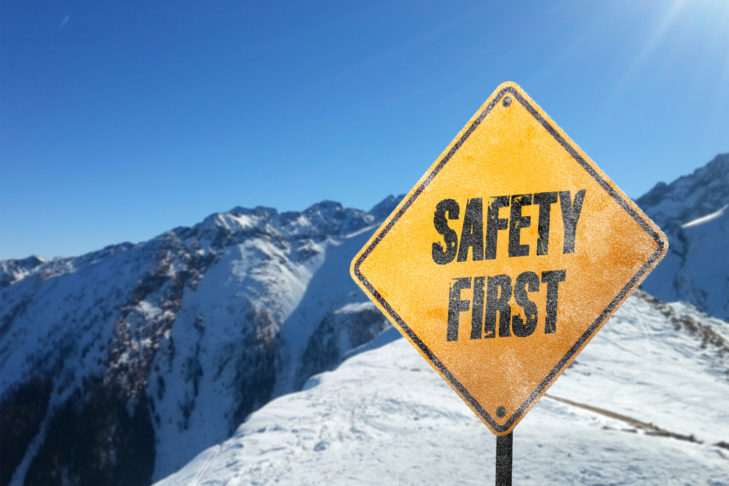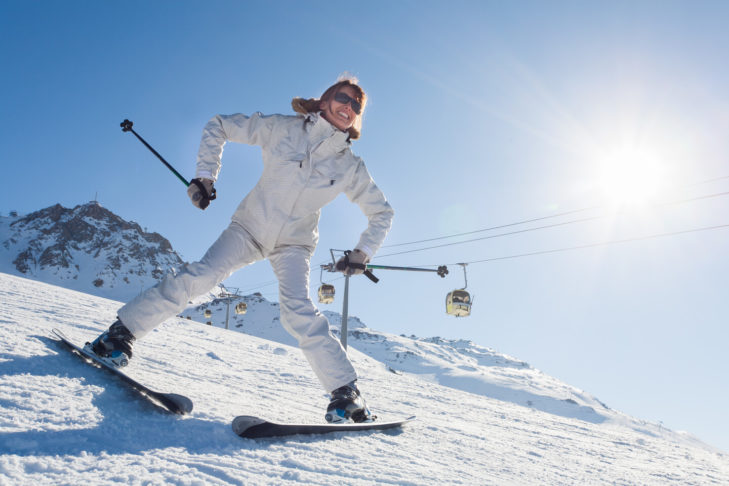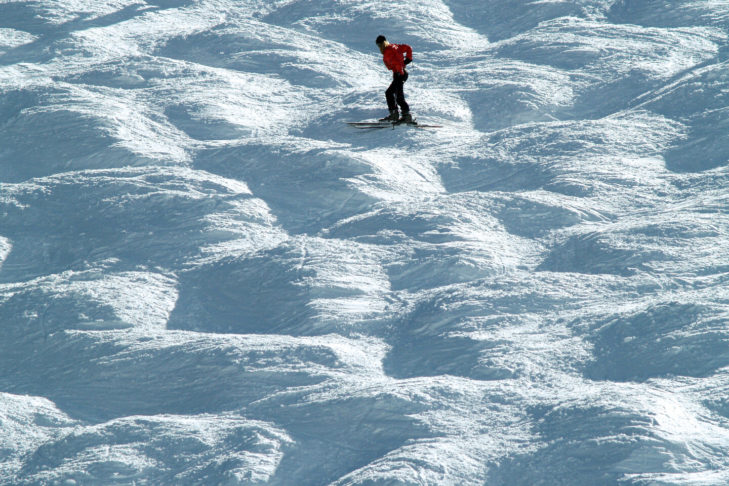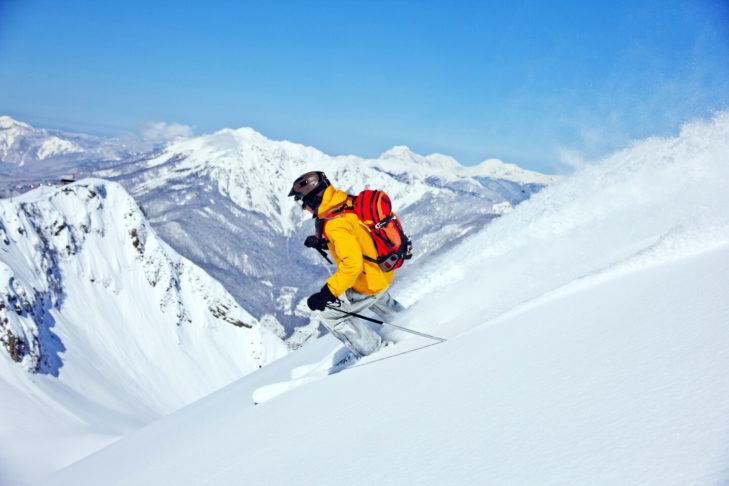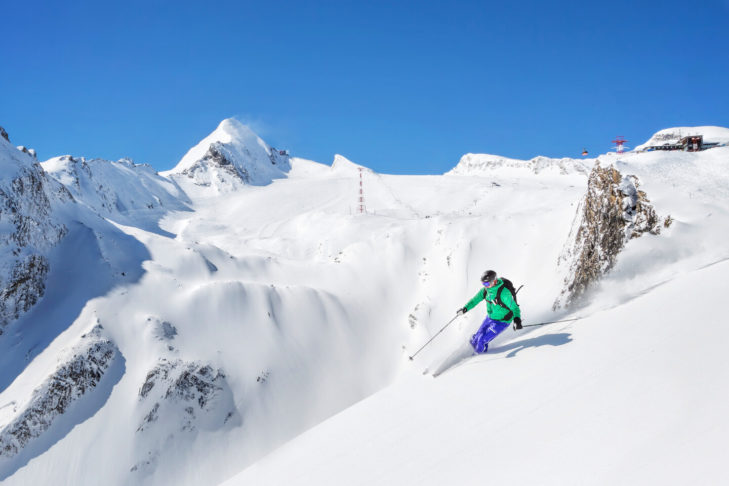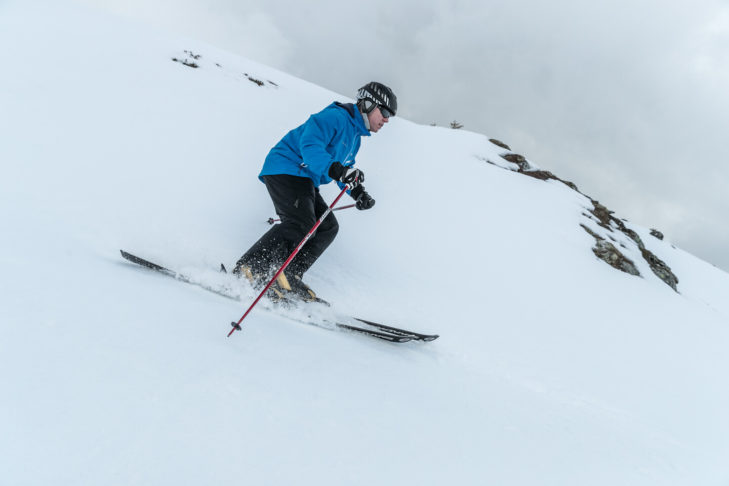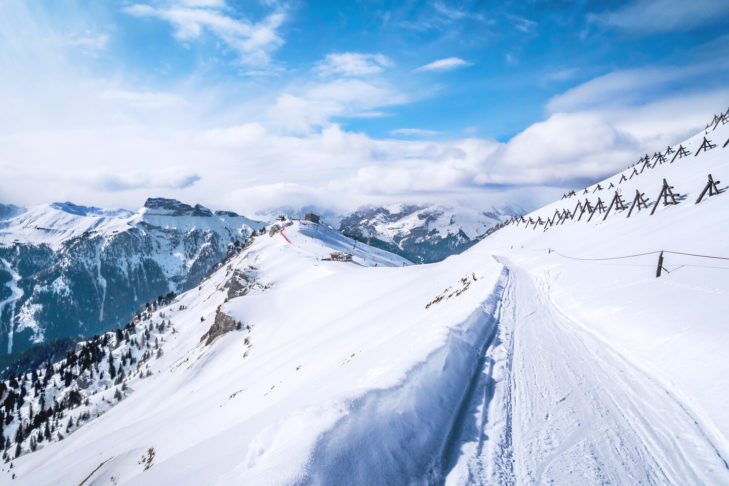Anyone who skis quickly notices: every slope is different and also requires different skiing techniques and adapted behaviour. This makes winter sports so beautifully versatile, but also challenging. However, once you get the hang of it and know which technique to use to master the various slopes, you will enjoy skiing in all its diversity. SnowTrex knows the safest skiing techniques and for steep, icy and hard slopes.
What are the different skiing styles & techniques?
Skiing is far more varied than many people think. Because when it comes to skiing, there is not just one technique that gets winter enthusiasts safely down the mountain. Whether beginner, advanced or professional, there is a suitable skiing technique for all skill levels to conquer flat, steep or icy slopes. But regardless of which skiing technique is targeted, the basis for a clean execution of the technique is found in the correct body posture. Only those who stand hip-width apart and on the soles of their feet on the skis can adapt their skiing style to the prevailing conditions in every situation. In addition, the hips, knees, and ankles should always be slightly bent.
This clip shows how skiers can move with the flow on piste:
Please also note that by using our services and integrating the YouTube API Services, the YouTube Terms of Service and the YouTube API Services Terms apply and your use of our website is deemed to be acceptance of these terms.
Carving
Carving is one of the best-known skiing techniques and is particularly suitable on wide, not particularly steep slopes. It combines beautiful and smooth turns with high speed. Particularly significant in carving is the strong inclination in which winter sports enthusiasts find themselves during a turn. The turns are made on the steel edges of the skis. The braking effect in the curve phase is much less when carving. The skis are guided over the slope as if on rails so that there is no sliding phase during the individual turns and the high speed is maintained.
It is particularly important to edge up equally with both skis and to put a little more weight on the downhill ski (also called the outside ski). In addition to the right carving skis, which have a stronger waist (wide shovel, narrow middle and wide end), a downhill body position also provides the necessary balance and stability.
After practising a few turns on the piste, the ruts left behind are the best way to check whether the carving has worked. If there are clean track marks, the skiing technique has been executed correctly.
Short turn
With the short turn technique, you have to act quickly and work a lot out of your legs. Because if you don’t change sides quickly enough, you will slide and then go down the hill uncontrollably sideways. In addition, the quick change slows down more so that the speed is taken away during the descent.
Initially, the upper body is positioned centrally over the skis. However, the short-term feeling of tipping over in front is only an optical illusion. In reality, the slight incline towards the valley is precisely centred due to the slope. In order not to fall, the skiing technique requires skiing on the edge as much as possible. The upturned edge prevents falling and takes the speed out of it. Therefore, it is important to apply almost constant pressure on the edges. This works more smoothly if you bend your knees while skiing. This allows the turning movements to be carried out more quickly. It is also critical to always put pressure on the downhill ski.
Starting from the stop, both the inner edges of the skis and the knees are tilted towards the mountain and the upper body now moves forward. If the movement is followed, the ski tip lifts and the skis automatically turn over the fall line to the other side. A good tip is to place the skis a little closer together than when carving. This provides a larger contact surface and more stability.
The short turn skiing technique is particularly suitable on narrow and especially steep slopes. Because if there is not enough space for sprawling skiing, the space-saving short turn technique helps. This makes it easier to move in tight spaces than through the sweeping curves of carving.
The following video shows how skiers can avoid the most common mistakes while doing short turns:
Please also note that by using our services and integrating the YouTube API Services, the YouTube Terms of Service and the YouTube API Services Terms apply and your use of our website is deemed to be acceptance of these terms.
Ploughing
Ploughing is particularly suitable for beginners and novices. As the name of the skiing technique suggests, the skis are arranged like a plough. This means that a V is formed with the skis. Meanwhile, the body weight is shifted forward. This technique does not allow high speed to be achieved, and a slow familiarization with skiing is possible. But not only beginners use this skiing technique to make their first descents on the piste. Even advanced and professional skiers use ploughing when controlled braking is required. Therefore, it is incredibly important to learn to plough right at the beginning of skiing to get a feel for the skis and controlled breaking.
Changeover turn
Immediately after learning to plough, the aim is to ski down the slopes a little faster thanks to the changeover turn technique. This involves shifting weight from one ski to the other. The key to this style of skiing is that you can only make turns by shifting your weight. The greater the weight shift, the tighter the turn. The style can be compared to a movement similar to climbing stairs. The correct implementation of the skiing technique can also be observed particularly well in other participants on the slopes. In some cases, observing other skiers can also provide helpful tips for improving one’s own technique. In general, the skiing technique of the changeover turn can be used on both easy and difficult pistes and is used by beginners through to professionals.
Skiing moguls
Mogul pistes are probably one of the most demanding and strenuous surfaces. To be ready for every bump or mogul, the right skiing technique requires a high degree of agility. Furthermore, you should have good body tension, stable core muscles and sufficient strength in the thighs. If the basic requirements are met, skiers can dare to take their first steps on a mogul slope. At first, the extremely tight turns needed to ski a mogul slope should be practised on normal slopes. Only when the basic skiing technique has been mastered can winter sports enthusiasts venture into somewhat undulating terrain and try to maintain their balance there.
Once the first two steps have been completed, you can finally move on to the mogul slope. The decisive factor at the beginning is speed control. For beginners, this means consciously making the first turns slowly and with special foresight. The correct skiing position is particularly important during the descent. The body’s centre of gravity should always be centrally above the ski to have sufficient control and balance. The ankle, knee and hip joints are constantly working and should be as mobile as possible to maintain contact with the snow. The upper body and arms, on the other hand, should be kept as still as possible.
If the piste has small to medium humps, these should be skirted. If it is no longer possible to ski around a hump, the legs should be tightened when driving up and stretched out again after the hump.High humps require a very high level of skill. In contrast to smaller humps, where the change of turn takes place between the humps, on high humps the change of direction must be carried out on the hump itself. In doing so, the legs are stretched during the turn and actively pulled in the direction of the upper body for the turn change.
Due to the high physical strain of a mogul slope, sufficient breaks are indispensable. So, it’s better to recharge your batteries a little more often than to risk injury due to physical exhaustion.
Skiing in deep powder snow
For many skiers, deep snow skiing is the absolute highlight of a ski holiday. But as nice and easy as practising the skiing technique looks, in reality it requires a lot of training and effort.The first step should be to get used to deep snow. This means diving into the deep snow off the groomed piste and then returning to the piste immediately afterwards. Once this is done, you can concentrate on your footwork. In contrast to many other techniques, the load should be distributed as equally as possible on both legs to prevent sinking in on one leg. In reality, however, there is an extra load on the outside ski. During the turn, the inner ski is deliberately loaded more. A maximum load contrast is shown when the outer ski is lifted during the turn. Shifting the weighting is particularly useful for maintaining balance, and can initially also be tried out on groomed slopes.
In addition, you can ski with a narrower leg position. This increases the surface effect of the skis, the lift is increased and skiing in powder becomes a lot easier. Rhythm is particularly important in the skiing technique of deep snow skiing. A steady and rhythmic up and down compresses the snow and creates the compacting effect, making it much easier to change turns. The so-called jetting describes the effect of straightening up backwards during the turn change. This lifts the ski tips out of the deep snow like a jet.
Eventually, this can be exhausting, but it makes it easier to ski in deep snow that is difficult to turn. To perform an optimal turn change, the upper body is turned ahead in the new turn direction. The forward movement should be transferred to the skis through body tension via the legs and support the movement from the legs. Especially in deep snow with high turning resistance, the pre-turn movement leads to an easier descent.
If you are looking for deep snow outside the groomed slopes, you should be very well-prepared. Because from avalanche danger to hidden, deep sinkholes around trees (tree-wells) to spontaneous weather changes, there are more dangers lurking here than on the piste. Skiing off-piste is therefore not for beginners. But even advanced skiers should never go off-piste alone and should always check the avalanche report and the weather forecast beforehand. In addition, off-piste skiing requires avalanche safety equipment as well as precise knowledge of the route. If you are not experienced in powder skiing, you can book a course or hire a ski guide who knows the area. This way, you can experience the fun of powder snow and still be safe.
Ski slopes can be so different
Ski slopes are categorized according to their level of difficulty: In the Alpine region, there are blue pistes for beginners, red pistes for advanced beginners and black pistes for advanced skiers. In France and North America, blue pistes for beginners can also be marked green.
The categories are primarily based on the degree of steepness. The steeper the slope, the more difficult it is. However, the exact angle is only legally defined for black pistes. Here, a longitudinal and transverse gradient of at least 40 percent applies. These classifications help skiers to choose the right piste according to their ability.
In addition, pistes also differ in their characteristics. A piste can be steep, humpy, icy, narrow, very crowded, empty, particularly flat or very soft and deep due to fresh powder snow. Stones and ice slabs can also hide under the snow. Depending on the conditions of the respective piste, winter sports enthusiasts must adapt their behaviour as well as their skiing technique accordingly.
Safety on the slopes begins with behaviour
What should not be forgotten is that proper skiing technique begins with one’s own behaviour. If you go onto the slopes well rested and well-trained, you will avoid many accidents. This applies all the more to difficult slopes that require increased attention. Lack of concentration increases the risk of accidents.In addition, the rules of conduct of the International Ski Federation (FIS) must always be observed during winter sports. According to these, winter sports enthusiasts must always show consideration for others and ski on sight. In addition, driving behaviour should be adapted to one’s own ability and the situation, and one should not overestimate one’s own abilities.
Winter sports enthusiasts should also check their equipment, regardless of the piste, and ensure that it meets current safety standards.
If you have to stop and pause on the piste, there are also a few things you should bear in mind to avoid collisions: “You should never stop abruptly. Immediate, rapid stops with a sharp change of direction take other skiers by surprise and there is a high potential for danger. You have to consider that following skiers do not always expect someone to stop. Therefore, it is important to gradually reduce your speed and approach the edge of the piste,” advises Max Holzmann of the German Ski Instructors Association (DSLV). He also emphasizes that breaks should only be taken at the edge of a slope. Winter sports enthusiasts should be just as attentive when starting out. First look up the slope and make sure of approaching traffic, then start slowly.
Safe skiing on steep slopes
How steep a slope really is, is usually only seen when you reach the top and look down into the valley. This is because the colour system of the pistes is only a rough guide. Depending on the snow conditions and visibility, the red and sometimes even black pistes can be mastered by beginners, but red pistes also meet the level of black skiers. So, what should be done if the planned descent is a very steep or difficult slope?
Safety before elegance
If a beginner who has only skied a few times on a blue slope accidentally finds himself on a black slope, he is best advised to take the lift or gondola back down the mountain. Because those who are still inexperienced risk accidents with serious injuries on the steep slopes.
More experienced skiers, on the other hand, can master steep slopes well with the necessary calm and the right skiing technique. If the slope is steeper than expected, one should not panic. On the other hand, it should not be tackled recklessly either, as skiing on steep slopes always requires the utmost concentration. After all, the most difficult challenge on steep descents is speed control. In order not to ski too fast and thus in an uncontrolled manner and consequently fall, skiers must be able to control their speed and take the pace out. This requires both physical and mental strength. If you are not careful or become reckless, you can quickly fall and possibly injure yourself.
Winter sports enthusiasts who find themselves on a slope that is too steep, but who have the confidence to ski down, ski most safely with the sliding technique. The skis are positioned at right angles to the slope, the downhill ski is loaded, and the upper body hangs centrally over the skis. Centred means that the upper body is slightly bent towards the valley. This requires a bit of courage, as it can give the feeling of falling downhill. In fact, however, this compensates for the slope and the skier keeps himself more stable. Now alternate between sliding and stopping phases. When sliding, the skis are in contact with the ground, when stopping, the inner edges are pushed towards the mountain. This does not look very elegant, but it is the simplest and safest form for those who do not yet have the confidence to turn on steep slopes.
The procedure can be practised on flat terrain with the so-called “sliding staircase”. This involves practising exactly the change of movement between sliding and edging to a stop.
Safe skiing on icy and hard slopes
Driving on icy or hard slopes is very similar to driving on steep slopes. This is because it is also a matter of not sliding away and controlling speed. Slopes can be hard or still icy, especially in the early morning, when the sun has not yet had enough time to soften them.
Speed and reaction in movements is important in these conditions. The faster the forces are transferred, the lower the risk of slipping on icy slopes. As with steep slopes, constantly applying pressure to the edges provides the necessary grip on icy slopes. Therefore, it is very critical to always walk with a well-polished edge on such terrain. Another tip is to buckle your boots a little tighter than usual. This ensures that the power transmission works better.
Skiing on icy or hard slopes requires basically the same as skiing on steep slopes. The positioning is in the middle over the ski and the upper body is leaned slightly away from the mountain for this purpose. More forward lean is better than too much backward lean. In an emergency, skiers merely slide to the side. This is done by putting weight on the downhill ski and also making the quick turn. To keep your balance better, you should never stand up completely, as this will cause you to lose your balance more quickly. In this way, winter sports enthusiasts can glide safely down the valley even on hard or icy slopes.
Safe skiing on narrow and crowded slopes
The skiing technique of short turns is not only suitable on hard, icy and steep slopes, it also helps skiers on narrow slopes. Once a good rhythm has been found here, this allows safe skiing in a tight radius and winter sports enthusiasts take up less space on narrow pistes.
Thus, the short turn is also a way of showing mutual consideration on crowded or narrow pistes. Here it is also important to ski with foresight and to be aware of your surroundings. Because on slopes where there is little space and many winter sports enthusiasts, collisions occur more easily. Around 10% of skiing accidents are caused by collisions. Foresight and consideration can prevent this.
Safe skiing on the “draw path”
As already mentioned, the short turn is a very helpful technique on difficult terrain. But it can also benefit you on the draw paths that connect pistes and uphill runs if the slope is steep enough. This is because the draw paths, as connecting routes, are often crowded and narrow, so there is not much room to move. They can also be icy or hard due to the intensive compression of the snow by the many winter sports enthusiasts. Those who have mastered the short turn are therefore advantaged.
Special rules of conduct also apply on the draw paths. There is no pushing. The slowest rider determines the pace. It is generally advisable to ski slowly if the path is unfamiliar, so as not to accidentally get caught in a slope.
In fact, you should not overtake on a draw path, as the space is very narrow and other skiers can be thrown off course as a result. This can quickly lead to accidents. If you still have to overtake, you should call ahead and leave enough space between you and the other skiers.Draw paths, however, can present skiers with another challenge: if they are quite flat, the downhill turn cannot be used.
The right skiing technique on flat terrain
For flat terrain when skiing, it helps to have foresight. If you recognize early on that it will soon be flat, you can ski onto the flat terrain with the appropriate momentum and thus take this energy with you.If it doesn’t go any further despite the momentum, the ski poles come into play. These are stuck into the snow to gain forward momentum. The skis slide forward one after the other, like pushing yourself on socks over a slippery wooden floor. This is a good technique for beginners.
A slightly more advanced option is to push the skis diagonally outwards with flowing gliding movements, as in skating. The poles support this movement.
The technique of the “double pole stroke” can also be borrowed from cross-country skiing. This involves pushing both poles firmly into the snow and pushing forward with full-body effort. The skis remain flat on the ground and slide forward. First the upper body is pushed forward, then the legs. However, this can become exhausting eventually.
If you want to get across from one slope to the next via a draw path with a slight incline, you position your skis across the slope. In contrast to the short turn, however, you now place your weight on the inside ski and glide over the draw path, pushing one ski in front of the other.
Upward movements on flat slopes
It can also happen that a small, relatively flat slope has to be skied up on a draw path. To achieve this, the skis are again placed across the slope. Then the ski that is higher up the hill is moved up. The position of the ski remains transverse to the slope. The lower ski follows. In this way, the skis always remain parallel.
Another method is to set up the skis like a “V”. The heels are together and point towards the valley, the tips are apart and point towards the summit. Then the left and right leg are lifted alternately, which is a bit reminiscent of a waddling “duck walk”. With the sticks, one additionally pushes oneself upwards. Although this may not look so elegant, it is an easy and safe way to get up a small hill.
Summary
Skiers are participants in the traffic on the slopes. They must be careful of their own and others’ skiing, and should ski at a speed appropriate to their ability. Weather conditions and piste conditions should always be considered, and skiers should only go slowly and stop at the edge of the piste. If you know which terrain requires which skiing techniques and behaviour, do not ski too fast and always take care. Additionally, by paying attention to the conditions of the piste as well as to the actions of other skiers, you can be sure of a safe skiing experience.
Tip from Trexpert Felix Neureuther
“Firstly, you should think about whether you have the skills to get down a black run. The most important thing is never to lose control while skiing. If in doubt, you should also be prepared to negotiate dangerous or icy sections by sliding or even to take the bypass sometimes.”
FAQs on skiing techniques
Can I ski the same way on every piste?
No, because different slopes require different skiing techniques. For example, skiing on flat terrain is different from skiing in deep snow or on icy, steep slopes. The rules of conduct, on the other hand, are the same: winter sports enthusiasts should not overestimate themselves and should not ski in a risky or reckless manner so as not to endanger anyone.
Is it enough to have a good skiing technique to ski safely?
Of course, skiers should master the various skiing techniques and be able to adapt their skiing style to the environment. But foremost, in addition to good equipment, careful, considerate skiing and good physical and mental preparation ensure safe skiing.
What can be done if skiers end up on a slope that is too steep?
If absolute beginners accidentally end up on a black slope, they should take the lift or gondola back down to the valley, as the slopes are beyond their ability and winter sports enthusiasts thus endanger both themselves and others. Otherwise, keep calm and have sufficient respect for the level of difficulty. If you have mastered the short turn technique, you can ski down safely. Otherwise, the sliding technique can be a safe skiing technique for beginners on steep slopes.
Why is the short turn so useful?
The short turn is suitable for skiing on difficult terrain, such as steep or icy slopes. In addition, it can also be used for considerate skiing on narrow and crowded slopes. The versatility of the riding technique is what makes it so helpful.
How to ski on flat terrain?
There are different skiing techniques for moving around on flat terrain on alpine skis. The easiest is to push yourself with the poles while alternating sliding movements forward with the skis.
Can beginners ski on moguls?
No! Mogul slopes are very demanding and require the highest concentration and a lot of skill. Therefore, they are not suitable for beginners. However, those who have mastered skiing on mogul slopes will do well on almost any terrain.
What is the best skiing technique for moguls?
On mogul slopes, you should always keep contact with the ground and make constant rhythmic high-low movements when skiing. The upper body is kept upright and steady, and the use of the poles comes carefully from the wrist. But skiing on moguls requires not only good skiing technique, but also good body tension, physical fitness and a lot of attention.
What are the dangers of deep snow?
If you seek deep snow outside the groomed slopes, you are on terrain with a higher avalanche risk and natural hazards such as tree-wells or bad weather conditions. In addition, the fast gliding in powder snow can tempt you into risky, too-fast skiing. This increases the risk of accidents. Anyone who rides off-piste must be properly equipped and trained. Optionally, a mountain guide or a deep-snow course can also be booked.
How can you improve your skiing?
Practice makes perfect. This also applies to skiing. If you dedicate yourself to skiing with a lot of patience, you will see clear improvements after a short time. In addition to good readings on proper skiing technique, it is also advantageous to enlist the help of a ski instructor to work on minor technical details.
How does carving work?
When carving, the skis are guided over the slope like rails so that there is no sliding phase during the individual turns. The curves are made on the steel edges of the skis. The right carving skis are also relevant for the correct carving technique. These have a stronger waist.
What does skiing involve?
Skiing is about skiing down a snow-covered mountain on skis. The upward and downward bevelling of the skis, i.e. making turns using the edges of the skis, is crucial here, as well as the shifting of body weight and the turning movements when making turns. If these three basic principles are followed, it is possible to conquer the descent of a mountain.
What do you need to pay attention to when skiing?
When skiing, it is crucial to correctly assess your own physical abilities. If these are overestimated, accidents and injuries can quickly occur due to the high strain. In addition, the three basic principles should be observed. These are the upward and downward edging of the skis, the shifting of body weight, and the correct turning movement in the curves. To learn these, beginners should seek the help of a ski instructor.

